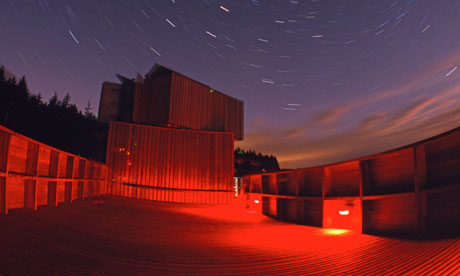
Why should I go to a forest to look at stars?
In a word, darkness. In built-up areas, light pollution blots out all but the brightest stars – to the extent that many of us have never been able to pick out the sparkling ribbon of the Milky Way – whereas seriously dark skies can still be found above much Forestry Commission land.
The 3,440-hectare Dalby Forest in Yorkshire, for example, has been given a top rating by the UK Dark Sky Discovery Network, while Kielder Water and Forest Park in Northumberland is bidding to become England's first internationally recognised "dark sky park". Alice Holt Forest in Surrey also has dark sky status.
Sorry to sound a bit dubious – but don't the trees get in the way?
Three more words: find a clearing.
Will I need a telescope?
Not if you're just starting out, although binoculars will make it easier to examine the moon. If you want to identify the planets and constellations, your best aid is a knowledgeable friend – or one of the many astronomy apps that will name anything you point a smartphone or tablet at.
Planning helps: the website Astronomy Central tells you what you can see from the UK every night. And remember that while the moon will make it easier for you to find your way around, it will also mask many stars.
Is there anything special I should be looking for?
Meteor showers! We're only a fortnight away from the Perseids, a prolific shower linked to the comet Swift-Tuttle which peak around 10-13 August. The meteors come thick and fast: other highlights are the Orionids, (21 October); the Leonids, (16-17 November); the Geminids, (13-14 December) and the Quadrantids, (2-3 January). The website EarthSky has full details of this year's meteor showers.
Are there any organised activities to help me see more stars?
Kielder Observatory Astronomical Society runs 150 events a year, ranging from "public observing" sessions that let you use the observatory's powerful telescopes, to "aurora nights" studying the northern lights.
At Dalby Forest, Scarborough and Ryedale Astronomical Society holds monthly stargazing events and stages a three-night "starfest" every August. Elsewhere, there's a "forest night adventure" at Rendlesham Forest in Suffolk on 24 August, while on 15 September, Alice Holt Forest hosts a "solar Sunday" with Farnham Astronomical Society. You won't even need to stay up for this, as the society will be (carefully) pointing its telescope at the sun.
And what if I just want to go to my local wood?
Most Forestry Commission sites are accessible 24 hours a day on foot, though car parks and roads may be closed at night. If you arrive around dusk, there'll be a little light to guide you to your chosen spot. Just remember you'll also need to find your way back out …
Any more tips?
However hot the day has been, bring warm clothes, mosquito repellent and a couple of torches with fully charged batteries (in case you lose or break the first one). Ideally, one will have a red-tinted lens, as this won't damage your night vision. And if you're going anywhere isolated, tell someone about your route and check in with them when you get back – or better still, take a friend.
Finally, don't count on navigating by the skies. Even if you know what you're doing, you'll feel stupid if the moon sets earlier than you expected or clouds cover the pole star.
On the UFO trail
If you want to search for something really unusual in the sky – day or night – a trip to Rendlesham Forest in Suffolk might just inspire you. This was, after all, the scene of "Britain's Roswell incident", a legendary UFO sighting – and possible landing – in December 1980.
A number of US Air Force personnel stationed at nearby RAF Woodbridge reported some very curious sightings over a two- or three-day period. Alerted by mysterious lights in the forest, some servicemen claimed that they had seen – and even touched – an alien spacecraft.
The incident has sparked more public correspondence with government officials than any other British UFO sighting – not to mention regular pilgrimages to the forest by avid amateur ufologists.
In honour of this, the Forestry Commission has created a three-mile UFO trail for children of all ages to enjoy. Graded easy, it includes strange alien-looking symbols on marker posts to spot, and an unidentified message to decode using the Alien Trail leaflet.
Note: to avoid any disappointed children (or adults), we should just point out that the walk contains no actual visible evidence that aliens ever visited Rendlesham Forest. But that doesn't stop the conspiracy theorists believing there was a huge cover-up by the British and US governments.

